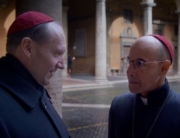Of all the films in the official Cannes Film Festival competition this year, Carol should have been awarded the Most Valuable Player. It ticks off nearly all the boxes: strong acting all around; a rich, muted, Edward Hopper–esque palette; impeccable period details, namely the prim and proper costuming; and, most importantly, the straightforward direction by Todd Haynes, which never calls attention to itself or detracts the focus from his actors. Few (Son of Saul) could match it for consistency and texture. However, the tastefully polished production offers few surprises.
Because the drama showcases two strong lead actresses, it was a given that it was a shoe-in for the Best Actress award. Only one question remained: Which actress would win, Cate Blanchett or Rooney Mara? At the closing awards ceremony, there were some murmurs when a tie was announced. Many assumed Carol had scored a double victory. However, only one of its stars shared the award with the co-winner, French actress Emmanuelle Bercot (for her meaty but overwrought role in Mon Roi): Mara, and not the presumed favorite, Blanchett.
Yet it should not have been a shocker. Even though Blanchett plays the title character, the movie actually belongs to Mara. The film is really about her waifish character, Therese, who is presumably a stand-in for author Patricia Highsmith, given that the script is based on her semi-autobiographical 1952 novel The Price of Salt, written under the pseudonym Claire Morgan when she was in her early thirties. While Blanchett’s Carol grabs the center of attention, Mara has significantly more screen time than her co-star and delivers a more intriguing, precise, and subtle performance, one that invites audiences in. Thanks to her, the ending lands a punch.
The contrast in the acting choices of Blanchett and Mara creates a built-in tension for a storyline about two women who, in the early 1950s, tiptoe toward a love affair that’s more tentative than torrid. Phyllis Nagy’s screenplay gently but firmly underlines the women’s differences, not least of which is their 15-to-20 year age gap. Carol Aird has settled down in the suburbs with her broad-shouldered husband (Kyle Chandler, in the film’s only heavy-handed portrayal) and their young daughter. Therese Belivet, a recent Midwest transplant to New York City, works as a shopgirl at a Bloomingdale’s-style emporium, where she first meets customer Carol and helps her to select a Christmas present for her little girl.
Therese has just begun figuring out that she wants to become a photographer, and she will later wonder if she should proceed in a relationship with a woman who has a vindictive and litigious spouse. (Carol’s secret is out in the open to him long before the film begins.) Putting on a front, Carol relies on style, sporting a formidable armor of Chanel-like woolen suits in egg shell and other warm (but not ostentatious) tones, complete with hat and gloves. Therese observes, taking everything in and recording it through photos. If it weren’t for Mara’s beaming blue eyes and translucent skin, Therese could fade into the dark woodwork.
Blanchett plays the upper-class New Jersey housewife in an era-specific performance, a throwback to the story’s late Truman–era time period. She speaks—purrs, actually—in the finishing school manner of mid-Atlantic speech, a blend of American dialect with soft but posh British elocution. No hard R’s, please. As a social butterfly, Carol gives Bette Davis a run for her money when it comes to smoking elegantly. She presides over get-togethers, dry martini in hand (when cocktails were dainty appetizers and not a jumbo-size main event), with a joviality that’s a little forced, as though she is trying to hide something, and she is. A combination of a graduate of Miss Porter’s School for Girls and a Park Avenue hostess with a sense of drama, Carol’s not terribly far removed from Blanchett’s turn in the contemporary-set Blue Jasmine. One could imagine Carol taking after such stage actresses as Katharine Cornell or Lynn Fontanne.
The self-effacing Therese, on the other hand, resembles wide-eyed wallflower Jane Wyman in Hitchcock’s Stage Fright, though less frumpy and with less severe bangs. The sensitive direction of Mara’s gradual, fluid transition enhances and enlivens what could otherwise have been a gussied-up but standard coming-out-and-of-age tale.
Don’t assume because this is directed by Haynes and features two lovers bumping and grinding against social convention in the ’50s that this is a retread of Far from Heaven. There’s no figurative winking to the camera; this one is played straight. The earlier film throws splashes of Technicolor on the screen, while the other keeps the color, and emotions, muted. There’s also no effort here to deconstruct a genre: the film is a full-on period piece loaded with implied contemporary relevance. Oddly enough, Carol ends on a more hopeful note than the smiling-through-tears Heaven, staying true to its source material’s conclusion, atypical for its time.
Despite the rosy glow, the handsome film’s limited budget sometimes reveals itself. It looks as though the film crew never left Ohio (where it was made)—even for a cross-country road trip that the women embark on from the Big Apple to Chicago, and with all due respect to Cincinnati, the metropolis doesn’t quite resemble mid-century midtown Manhattan.
More crucially, when the two women first meet, they lock eyes, yet the heat stays on low (noticeably, one of the actresses has a no-nudity clause in her contract). Say what you will about Blue Is the Warmest Color, but audiences could feel the attraction boomerang between its two young leads through the sometimes invasive but effective barrage of close-ups. Sex also took center stage way back in 1985’s Desert Hearts. Both films are randy and revolutionary compared to the more delicate and cool Carol. It’s not that sex has to be explicit, but it has to be at least implicit.
It was more than a little ironic that the scandal of the festival took place at Carol’s red carpet premiere, where life mirrored the film’s themes of women constricted by fixed social norms. According to Screen Daily, several women in their fifties were denied entry to the screening because they were wearing flats. Scandale! It’s as though the Old World dress code were a tie-in for the movie.
What to wear at Cannes can be hard to pin down. For certain daytime screenings, formal attire is required. Jeans and a T-shirt are fine, but no Bermuda shorts and flip-flops. For the evening premieres, men have it easy (a tux or a suit and tie), but I noticed many of my counterparts wore scruffy shoes that hadn’t been polished in years. For women, the choices are more open and vague. (I’m far from the first to remark how odd it is to have strict fashion enforcement for an event that promotes freedom of expression.) Carol is good, but this brouhaha brought out more passion among festivalgoers and the press than the movie, and for good reason. However, the film still benefits: a pair of flats made it feel more relevant.







Leave A Comment